Sanglier lock is
a picturesque place on the Canal du Midi
Sanglier lock is a typical example of how beautiful the Canal du Midi scenery can be. Just like many other places, this one was also shaped by inland waterway transport. The rural scenery makes it a great place for visitors to explore.
Sanglier lock is the perfect example of the beautiful scenery of the Canal du Midi
The origin of the name
It is not surprising to find out that this lock owes its name to a wild boar (sanglier in French). It is believed that in 1669, the builders working on the Canal du Midi had to kill a huge wild boar that was trapped in the lock chamber they were building.
Pierre-Paul Riquet stopped by the construction site the same day, bought the wild boar and took it to Pézenas. He treated some of his friends involved in the Estates of Languedoc assembly in this town to a banquet.
A lock built according to 17th century dimensions
In 1970, work was carried out on the Canal du Midi to modify the locks and align them with the Freycinet gauge, and as such, the rest of the national waterway network. The goal of these modifications was to give navigation a boost, as it had been severely impacted by the development of the railroad since the late 19th century.
The idea behind the modernisation work was simple: standardise the size of locks (40 m long and 5.5 m wide). The work began on the Canal de Garonne where all the locks were modified, but in the end only a few locks on either end of the Canal du Midi were concerned by the changes. The project was abandoned due to the decline in waterway traffic and the State's budget deficit.
Did you know?
Today, the locks in the central section of the Canal du Midi (140 km) are still the same size as in the 17th century, just like Sanglier lock.
A picturesque place, classified as a Historic Monument
The area around sanglier lock is one of the most scenic places on the Canal du Midi. In 1996, the Canal du Midi was recognised as a UNESCO World Heritage Site according to a set of cultural selection criteria that considers technological innovation, appearance, architecture and landscapes created.
Sanglier lock is the perfect example of a section of the canal that meets this criteria. With the lock, lock keeper's house and bridge, this place is the epitome of Canal du Midi architecture and scenery.
The whole site including the double lock built at the same time as the canal, the bridge from the early 19th century between the two basins and the lock keeper's house dating from 1752, is on the list of Historic Monuments.
The ideal stopover
From Ayguevives motorway
It is very easy to get to Sanglier lock from the Ayguevives motorway rest area just 300 metres away, barely 5 minutes on foot. It is a very pleasant place for drivers to stop off and explore a part of the Canal du Midi.
There are toilets and a picnic area at the motorway rest area that can also be used by cyclists and walkers exploring the Canal du Midi!
A stopover gite on the Santiago de Compostela hiking trail
The lock keeper's house is transformed into a stopover gite for hikers on the Santiago de Compostela trail, walking along the towpath between Naurouze and Toulouse.












